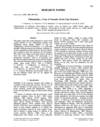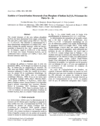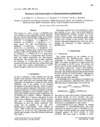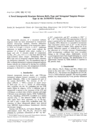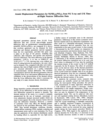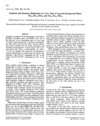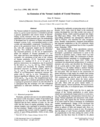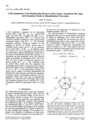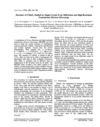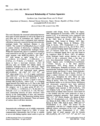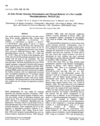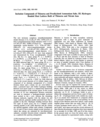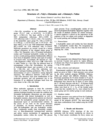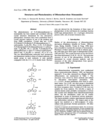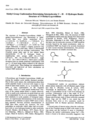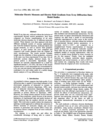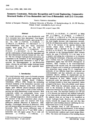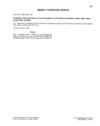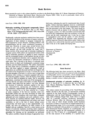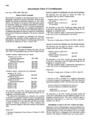issue contents
December 1996 issue

Cover illustration: Structural model of ZrnNb8-2nW12+nO56. Courtesy of F. Krumeich, G. Liedtke and W. Mader.
research papers
Download citation


Download citation


A single-crystal X-ray study was carried out on two villamaninite samples from Villamanín (León, Spain). The systematic structural refinement over subgroups of the pyrite Pa-3 space group leads to a monoclinic model, space group P1211, for this mineral.
Download citation


Download citation


The crystal structure of the new indium phosphate In3P2O8 is characterized by a three-dimensional arrangement of isolated PO43− tetrahedra forming the anionic network, while the electroneutrality is ensured by (In-In)4+ cationic pairs.
Download citation


Download citation


Three forms (cis-, trans-and β-trans-) of [Pd(NH3)2Cl2] were investigated by X-ray powder diffraction. The crystal structures obtained form the basis for considering the possible mechanisms of isomerization.
Download citation


Download citation


Electron diffraction and high-resolution transmission electron microscopy investigations reveal the structure of ZrnNb8-2nW12+nO56 (0.5<n<1). The characteristic structural features are double pentagons composed of edge-sharing five-membered rings of octahedra.
Download citation


Download citation


Excellent agreement is obtained between both positional and thermal parameters derived separately from very low-temperature X-ray and time-of-flight neutron diffraction data. This gives confidence in the deconvolution of thermal motion from the X-ray data in a subsequent calculation of the static electron density distribution.
Download citation


Download citation


The isomorphous phases Sb3+xNb3−xTiO14 and Sb3+xTa3−x-TiO14 have been discovered and their structures solved. They have layered structures related to those found in simpler oxides of SbIII and SbV.
A new methodology is defined for discriminating between different crystal structures on the basis of their Voronoi polyhedra.
The relationship between lattice strain and BO6 octahedral tilt angle is examined in rhombohedral perovskites, ABO3. Consideration is also given to factors governing the observed space group.
Download citation


Download citation


A combination of X-ray diffraction and high-resolution transmission electron microscopy has been used to study the crystal structure of UMoO5, obtained by hydrothermal and ceramic methods. The structure is related to that of UVO5.
Download citation


Download citation


The structural relationship between three types of metal squarates and the ligand squarate in its acid form and in its monoanion form is illustrated. It relies heavily on intra- and intermolecular hydrogen bonds.
Download citation


Download citation


X-ray investigations reveal details of structural change with temperature in the paraelectric phase of Rochelle salt-ammonium Rochelle salt mixed crystal.
Download citation


Download citation


The structure of layered Pb(O3PC6H5) has been determined ab initio from powder diffraction data by minimizing the preferred orientation. MAS-NMR has been used to confirm the triclinic structure with two independent structural units.
CCDC reference: 131899
Download citation


Download citation


The present series of thiourea-quaternary ammonium nitrate complexes exhibit two distinctly different types of thiourea-anion lattices depending on the stoichiometric ratio of thiourea to nitrate ion. Compouds (1) and (2) (3:1) are novel channel inclusion compounds, whereas (3), (4) and (5) (1:1) are each characterized by an anionic composite ribbon composed of a zigzag arrangement of thiourea molecules with nitrate ions attached to both sides.
Download citation


Download citation


The title compounds were compared with other mixed hydrophobic-hydrophilic dipeptides. Emphasis is placed on crystal packing patterns and hydrogen-bond preferences.
Download citation


Download citation


The photochemistry of 9,10-ethenoanthracene-11-monoamides has been studied and correlated with the crystal structures determined for two derivatives; photoproduct structures have been established from a crystal structure analysis of one of the products and from NMR correlations. Mechanisms are derived for the formation of three types of photoproduct: (i) the well known di-i-methane reaction [(2M)-type photoproduct]; (ii) a hydrogen abstraction process [(2H)]; (iii) β-lactam formation [(2L)].
Download citation


Download citation


In crystalline N-methyl-2-pyrrolidone (NMP) the N-methyl group takes part in two intermolecular C-H⋯O hydrogen bonds, which cause a notable deviation from its usually preferred conformation with one C-H bond being almost eclipsed to the adjacent N-C amide bond. This is substantiated by force-field and ab initio calculations on isolated NMP molecules.
CCDC reference: 131916
Model X-ray data sets are computed from ab initio molecular electron densities for 12 different molecular crystals. By the use of several multipole models, molecular dipole and second moments, as well as electric field gradients at each nuclear site, are computed and compared with those from the original ab initio wavefunctions. The results provide valuable insight into the reliability of these properties extracted in the same way from experimental X-ray data.
Download citation


Download citation


The incommensurate structure of hexamethylenetetramine suberate is characterized by large non-sinusoidal displacements of up to 1 Å. The modulation results from the constrained packing of the aliphatic chains with layers of hexamine.
Download citation


Download citation


The crystal structure of two urea-α,ω-dicarboxylic acid cocrystals (2:1) are determined. The geometry and the conformation of the comolecular units and their parent molecules are studied with respect to the three-dimensional network organization. The effective molecular recognition in crystals is demonstrated to be not only dynamically selective and functionally complementary, but also a toposelective and symmetry-constrained process.
short communications
Correction to Acta Cryst. (1996), B52, 806-809.
book reviews
Free 

books received
Free 

international union of crystallography
Free 



 journal menu
journal menu











